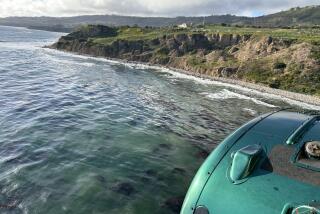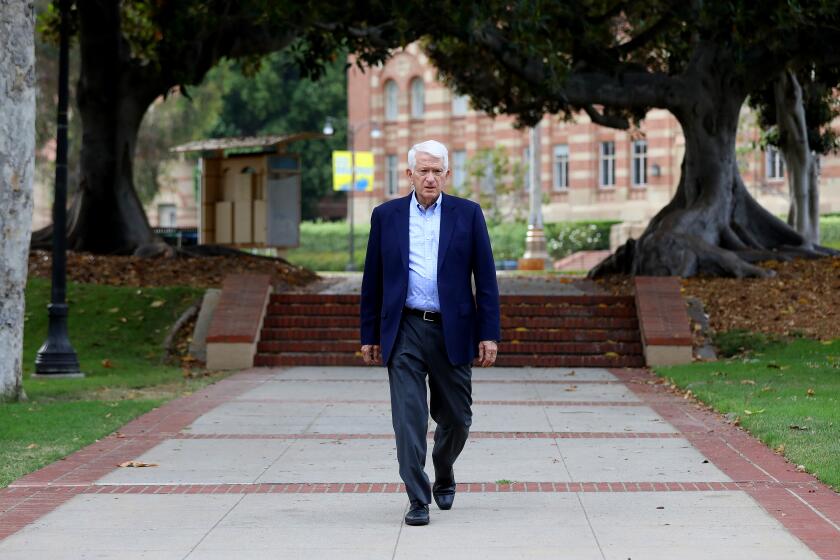Crash Raises Neighbors’ Concerns on Flight Safety
The crash of a home-built aircraft into a Mar Vista neighborhood Sunday left Santa Monica residents shaken and airport officials looking at ways to improve air safety and prevent similar incidents.
“We’re concerned. We don’t want the planes coming down on our heads,” said Paul Scheer, a leader of Rose Avenue Neighbors, an association of homeowners near Santa Monica Airport.
“Santa Monica is one of the busiest single-runway airports in the nation--if not the busiest--and as the volume increases, so does the likelihood of problems,” said Scheer, who lives less than a mile from the site of the latest crash.
Sunday’s accident, the fifth in the last two years, left pilot William Davenport with serious head injuries when his single-engine, experimental plane apparently stalled after takeoff about 1 p.m. Davenport, a 62-year-old Mar Vista resident, attempted to return to the airport, and his plane struck power lines and crashed into a residential garage south of the airport in the 13200 block of Warren Avenue, officials said.
Now residents in the densely populated neighborhoods surrounding the airport worry that a plane will hit their homes next time.
Airport Commissioner Brian Ouzounian, who often represents the view of the residents on the commission, said he has received many calls from worried neighbors.
“It’s rekindled the fire,” he said. “We were very fortunate that no one on the ground was hurt, but next time we may not be so lucky,” Ouzounian said.
The cause of the crash is still unknown and officials are not alleging that it was because the plane was an experimental-type, Walsh said. The plane may look like something out of a “Star Trek” movie, but the Long-Eze aircraft has actually been around for nearly 20 years and was designed by one of the country’s best-known aviators, Burt Rutan.
“They’re considered one of the safest aircraft in their category,” Walsh said. “They have a tremendous glide ratio, meaning if the plane has an engine failure it can travel a great distance with no power.”
The glide ratio, however, was not enough for Davenport to return to the airport. Known around the airfield as a skilled pilot, Davenport remained hospitalized at UCLA Medical Center, where his condition was upgraded Tuesday from serious to fair.
Since the crash, officials have proposed several measures they say will improve air safety.
For example, Santa Monica Airport Manager Tim Walsh said he was going to suggest the FAA raise its annual inspection requirements for experimental aircraft. Currently, he said, the inspections of experimental planes can be conducted by their builders rather than specially licensed engineers who annually inspect production-line planes such as those made by Beechcraft and Cessna.
“We’re worried that anyone can sign off an experimental plane as airworthy,” he said, adding: “We would like to see it treated the same as all other aircraft.”
Another suggestion, passed on to him by Airport Commissioner Mary Rose, asks that large orange balls be hung on power lines around the airport to help pilots see the wires. In the last five crashes, four of the planes struck power lines, Walsh said.
Concerned about aircraft safety in 1994, the Airport Commission formed the Airport Safety Committee, which consists of representatives of neighborhood groups, pilots and FAA officials. The committee came up with 37 recommendations, including specific suggestions to improve pilot proficiency. Walsh said 21 recommendations have been implemented so far.
One of the committee’s suggestions that has not yet been implemented may have affected Sunday’s crash. In order to help pilots recognize off-airport landing sites, the committee recommended making a videotape of emergency landing sites that can be used if a plane cannot get back to the airport.
Davenport had apparently tried to return to the airport after his engine quit rather than seeking an alternative landing site, Walsh said. Returning to the airport is sometimes risky because turning can cause a plane to quickly loose lift. (In the past, the Penmar Golf Course just southwest of Santa Monica Airport has served as an emergency landing field.)
Walsh also suggested additional pilot training in how to handle in-flight emergencies. Currently, pilots in multi-engine planes receive instructions that their course of action in an emergency should be based on their altitude. Perhaps, Walsh said, single-engine pilots also need to be knowledgeable about how their altitude will affect their landing options.
“Emergency procedure training is something no one can have too much of,” Walsh said.
Ouzounian and Scheer said they were pleased with Walsh’s recommendations.
“I believe the FAA and airport management know the problem, and they are in the best position to solve them,” Ouzounian said.
More to Read
Start your day right
Sign up for Essential California for news, features and recommendations from the L.A. Times and beyond in your inbox six days a week.
You may occasionally receive promotional content from the Los Angeles Times.






